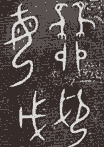Chinese Pictographic Character - Horse
2014 Chinese Horoscope - The Year of Green Horse
The following are nine sample Chinese characters of the horse. They are found in the history of the development of Chinese characters and calligraphy.
![]()
 The first character is from the Bronze Vessel inscriptions, which are the earliest pictographic characters in the Chinese history. Bronze Vessel inscriptions were used around 1500-1100 B.C. Also, different pictographs of horses
The first character is from the Bronze Vessel inscriptions, which are the earliest pictographic characters in the Chinese history. Bronze Vessel inscriptions were used around 1500-1100 B.C. Also, different pictographs of horses ![]() were found. Some Chinese scholars still believe that the horse character should develop from the symbols of
were found. Some Chinese scholars still believe that the horse character should develop from the symbols of ![]() before the Bronze Vessel inscriptions.
before the Bronze Vessel inscriptions.
 The second character is from the Oracle Bone inscriptions, around 1300-1100 B.C. Many Chinese basic characters are developed from here. Oracle Bone characters were simplified the drawing lines from Bronze characters. More than one horse inscriptions
The second character is from the Oracle Bone inscriptions, around 1300-1100 B.C. Many Chinese basic characters are developed from here. Oracle Bone characters were simplified the drawing lines from Bronze characters. More than one horse inscriptions ![]() were also found. We can see the drawing of the entire horse body in the horse characters.
were also found. We can see the drawing of the entire horse body in the horse characters.
The third character is a Large-Seal Script, about 800 B.C. Because the Bronze and Bone pictographs were differently carved for the same object, the Large-Seal Script was invented to make Chinese characters easier.
The 4th character is a Small-Seal script, 206 BC-AD 220 '200 B.C. It simplified and unified the Large-Seal characters. More new characters were created.
The following characters are from the Chinese calligraphy, which are still using today.
The 5th character is a Clerical script, since 200 A.D.
The 6th character is a Standard script, since 400 A.D.
The 7th character is a Running script, since 400 A.D.
The 8th character is a Cursive script, since 400 A.D.
The 9th character is a Simplified script, since 1950 A.D.
The Chinese traditional (standard) character horse  using in Taiwan and Hong Kong today is vividly depicted with horse's mane, legs, and tail. The Chinese simplified character
using in Taiwan and Hong Kong today is vividly depicted with horse's mane, legs, and tail. The Chinese simplified character  using in China today cannot tell a horse has four legs.
using in China today cannot tell a horse has four legs.
About Chinese Characters
 The earliest Chinese characters are found on the bronze vessels, not the tortoise shells and animal bones. Just like ancient Egyptian characters, Chinese earliest characters are pictographic characters. Unlike many countries develop their pictographic characters into phonetic characters, Chinese retain the pictographic, ideographic and phonetic characters together.
The earliest Chinese characters are found on the bronze vessels, not the tortoise shells and animal bones. Just like ancient Egyptian characters, Chinese earliest characters are pictographic characters. Unlike many countries develop their pictographic characters into phonetic characters, Chinese retain the pictographic, ideographic and phonetic characters together.
There are six types of Chinese characters.
 Pictographic characters are symbols with simple drawing lines according to the object's shape or characteristic. For example, the Mountain character
Pictographic characters are symbols with simple drawing lines according to the object's shape or characteristic. For example, the Mountain character ![]() comes from
comes from ![]() . The following characters are sun, moon, mountain, water (river), bird and horse.
. The following characters are sun, moon, mountain, water (river), bird and horse.  They were developed from left to right.
They were developed from left to right.
Ideographic characters are abstract and self-explanatory symbols. For example, the Up character ![]() comes from
comes from ![]() and the Down character
and the Down character ![]() comes from
comes from ![]() .
.
Logical Aggregate characters combine two different meanings of characters as a new meaning. For example, the Small character ![]() on the top and the Big character
on the top and the Big character ![]() on the bottom become Sharp Point character
on the bottom become Sharp Point character ![]() .
.
Phonetic characters are combining characters and one of the characters is for the pronunciation. For example, the Sleep character ![]() is combined by characters Eye
is combined by characters Eye ![]() and Drop
and Drop ![]() . The Eye character is from
. The Eye character is from ![]() and the Drop character
and the Drop character ![]() is the sound to pronounce.
is the sound to pronounce.
Invented (transformation) characters extend a meaning of a character to a related concept.
Borrowing charactersgive an unrelated meaning to a character by borrowing the same pronunciation character.
How Old is the China?
- 2013 is Year 4710 in the Chinese Calendar. Explanation at Chinese New Year 2013
- Chinese civilization is up to 8000 years.
-
Dadiwan Civilization had houses, cooking tools, color pottery, artifacts and agriculture. Archeologists doubt the I-Ching was invested there.
Where Do 12-Branch Symbols Come From?
Chinese Pictographic Characters - Sheep
Chinese Zodiac
- Your Zodiac Sign
- Your Chinese Astrology Birth Chart
- Where Does the Yin Yang Symbol Come?
- Chinese Facial Mole Reading
- 2021 Chinese New Year of the Ox
- Celebrity Chinese Astrology
- Pig Characteristics and Traits
- Cow Characteristics and Traits
- Dog Characteristics and Traits
- Rat Characteristics and Traits
- Sheep Characteristics and Traits